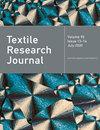FabricGAN: an enhanced generative adversarial network for data augmentation and improved fabric defect detection
IF 1.9
4区 工程技术
Q2 MATERIALS SCIENCE, TEXTILES
引用次数: 0
Abstract
When deep learning is applied to intelligent textile defect detection, the insufficient training data may result in low accuracy and poor adaptability of varying defect types of the trained defect model. To address the above problem, an enhanced generative adversarial network for data augmentation and improved fabric defect detection was proposed. Firstly, the dataset is preprocessed to generate defect localization maps, which are combined with non-defective fabric images and input into the network for training, which helps to better extract defect features. In addition, by utilizing a Double U-Net network, the fusion of defects and textures is enhanced. Next, random noise and the multi-head attention mechanism are introduced to improve the model’s generalization ability and enhance the realism and diversity of the generated images. Finally, we merge the newly generated defect image data with the original defect data to realize the data enhancement. Comparison experiments were performed using the YOLOv3 object detection model on the training data before and after data enhancement. The experimental results show a significant accuracy improvement for five defect types – float, line, knot, hole, and stain – increasing from 41%, 44%, 38%, 42%, and 41% to 78%, 76%, 72%, 67%, and 64%, respectively.FabricGAN:用于数据增强和改进织物缺陷检测的增强型生成对抗网络
在将深度学习应用于智能纺织品疵点检测时,训练数据不足可能会导致训练出的疵点模型准确率低、对不同疵点类型的适应性差。针对上述问题,提出了一种用于数据增强和改进织物缺陷检测的增强生成对抗网络。首先,对数据集进行预处理以生成疵点定位图,然后将其与非疵点织物图像相结合并输入网络进行训练,这有助于更好地提取疵点特征。此外,通过使用双 U-Net 网络,疵点和纹理的融合也得到了增强。接下来,我们引入了随机噪声和多头关注机制,以提高模型的泛化能力,并增强生成图像的真实性和多样性。最后,我们将新生成的缺陷图像数据与原始缺陷数据合并,实现数据增强。使用 YOLOv3 物体检测模型对数据增强前后的训练数据进行了对比实验。实验结果表明,浮点、线、结、孔和污点这五种缺陷类型的准确率有了显著提高,分别从 41%、44%、38%、42% 和 41% 提高到 78%、76%、72%、67% 和 64%。
本文章由计算机程序翻译,如有差异,请以英文原文为准。
求助全文
约1分钟内获得全文
求助全文
来源期刊

Textile Research Journal
工程技术-材料科学:纺织
CiteScore
4.00
自引率
21.70%
发文量
309
审稿时长
1.5 months
期刊介绍:
The Textile Research Journal is the leading peer reviewed Journal for textile research. It is devoted to the dissemination of fundamental, theoretical and applied scientific knowledge in materials, chemistry, manufacture and system sciences related to fibers, fibrous assemblies and textiles. The Journal serves authors and subscribers worldwide, and it is selective in accepting contributions on the basis of merit, novelty and originality.
 求助内容:
求助内容: 应助结果提醒方式:
应助结果提醒方式:


